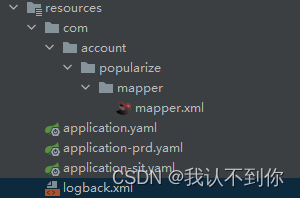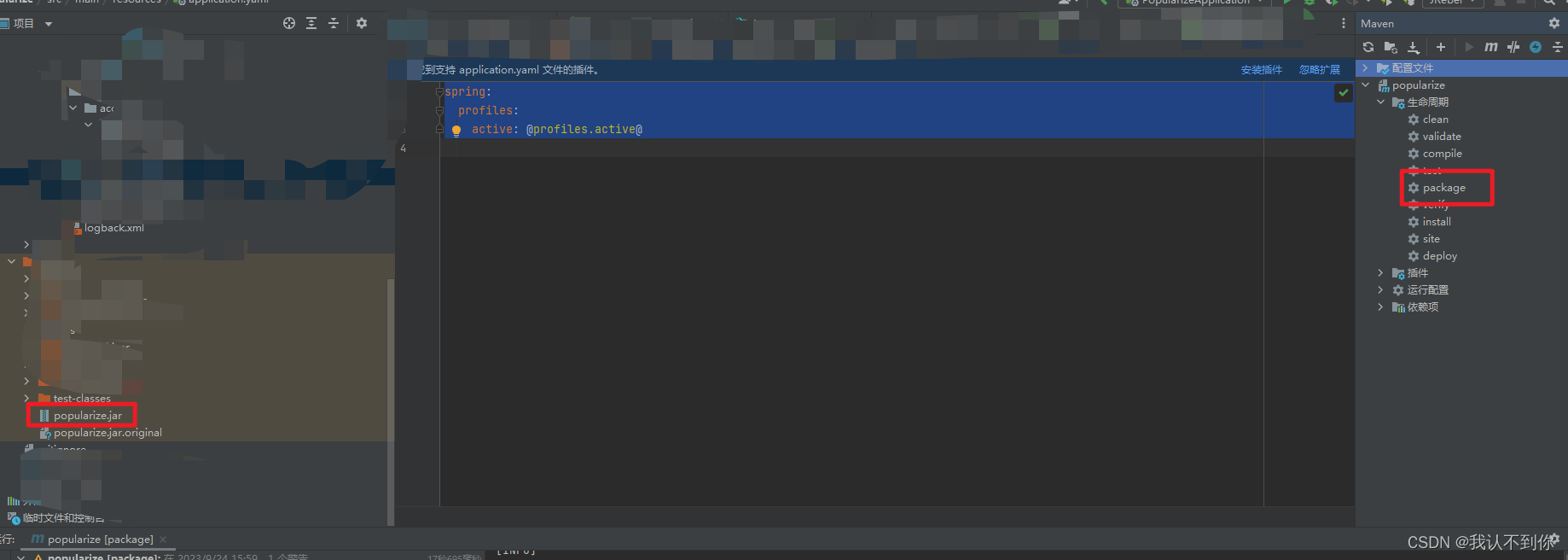-
Linux使用一个脚本启用、停用springboot项目(本文带脚本)
前言
如果仅需要脚本的小伙伴可以下拉至后面,我这里一步一步交大家发布项目
学习之前我们要先会搭建一个项目
可以去看这篇文章:搭建一个SpringBoot项目
一、首先我们配置多环境
0、resources文件如下

1、配置pom.xml文件
<build> <finalName>popularizefinalName> <resources> <resource> <directory>src/main/resourcesdirectory> <includes> <include>**/*.xmlinclude> <include>**/*.propertiesinclude> <include>**/*.yamlinclude> <include>**/*.ymlinclude> includes> <filtering>truefiltering> resource> resources> <plugins> <plugin> <groupId>org.springframework.bootgroupId> <artifactId>spring-boot-maven-pluginartifactId> <configuration> <excludes> <exclude> <groupId>org.projectlombokgroupId> <artifactId>lombokartifactId> exclude> excludes> configuration> plugin> plugins> build> <profiles> <profile> <id>sitid> <properties> <profiles.active>sitprofiles.active> properties> <activation> <activeByDefault>trueactiveByDefault> activation> profile> <profile> <id>prdid> <properties> <profiles.active>prdprofiles.active> properties> profile> profiles>- 1
- 2
- 3
- 4
- 5
- 6
- 7
- 8
- 9
- 10
- 11
- 12
- 13
- 14
- 15
- 16
- 17
- 18
- 19
- 20
- 21
- 22
- 23
- 24
- 25
- 26
- 27
- 28
- 29
- 30
- 31
- 32
- 33
- 34
- 35
- 36
- 37
- 38
- 39
- 40
- 41
- 42
- 43
- 44
- 45
- 46
- 47
- 48
- 49
- 50
- 51
- 52
- 53
2、配置application.yaml文件(对应pom.xml中的不同环境)
spring: profiles: active: @profiles.active@- 1
- 2
- 3
3、右键刷新
**

**4、idea(maven)打包

二、打包之后我们放到指定的Linux文件夹中

三、编写脚本
1、文件名随便取(我的就叫jar.sh)
#!/bin/bash #这里可替换为你自己的执行程序,其他代码无需更改 APP_NAME=popularize.jar #项目路径 PROJECT_PATH=/popularize #项目环境,比如我的是开发环境是sit,生成环境是prd ENV=prd #使用说明,用来提示输入参数 usage() { echo "使用方法: 脚本名.sh [start|stop|restart|status]" echo "使用方法: ./脚本名.sh start 是启动" echo "使用方法: ./脚本名.sh stop 是停止" echo "使用方法: ./脚本名.sh status 是查看输出运行状态" echo "使用方法: ./脚本名.sh restart 是重启" exit 1 } #检查程序是否在运行 is_exist(){ pid=`ps -ef|grep $APP_NAME|grep -v grep|awk '{print $2}' ` #如果不存在返回1,存在返回0 if [ -z "${pid}" ]; then return 1 else return 0 fi } #启动方法 start(){ is_exist if [ $? -eq "0" ]; then echo "${APP_NAME} is already running. pid=${pid} ." else nohup java -Dspring.profiles.active=$ENV -jar $PROJECT_PATH/$APP_NAME > /dev/null 2>&1 & echo "${APP_NAME} start success" fi } #停止方法 stop(){ is_exist if [ $? -eq "0" ]; then kill -9 $pid else echo "${APP_NAME} is not running" fi } #输出运行状态 status(){ is_exist if [ $? -eq "0" ]; then echo "${APP_NAME} is running. Pid is ${pid}" else echo "${APP_NAME} is NOT running." fi } #重启 restart(){ stop start } #根据输入参数,选择执行对应方法,不输入则执行使用说明 case "$1" in "start") start ;; "stop") stop ;; "status") status ;; "restart") restart ;; *) usage ;; esac- 1
- 2
- 3
- 4
- 5
- 6
- 7
- 8
- 9
- 10
- 11
- 12
- 13
- 14
- 15
- 16
- 17
- 18
- 19
- 20
- 21
- 22
- 23
- 24
- 25
- 26
- 27
- 28
- 29
- 30
- 31
- 32
- 33
- 34
- 35
- 36
- 37
- 38
- 39
- 40
- 41
- 42
- 43
- 44
- 45
- 46
- 47
- 48
- 49
- 50
- 51
- 52
- 53
- 54
- 55
- 56
- 57
- 58
- 59
- 60
- 61
- 62
- 63
- 64
- 65
- 66
- 67
- 68
- 69
- 70
- 71
- 72
- 73
- 74
- 75
- 76
- 77
- 78
- 79
- 80
- 81
- 82
- 83
- 84
2、随便放到哪个文件夹下面,在当前目录下授权文件
chmod 744 springjar.sh- 1
3、使用
- 启动服务,在当前目录下执行:
./jar.sh start - 关闭服务,在当前目录下执行:
./jar.sh stop - 重启服务,在当前目录下执行:
./jar.sh restart - 查看服务状态,在当前目录下执行:
./jar.sh status
四、讲解脚本
0、输入参数,就是
./jar.sh后面的参数,根据参数不同进入不同的方法# 根据输入参数,选择执行对应方法,不输入则执行使用说明 case "$1" in "start") start ;; "stop") stop ;; "status") status ;; "restart") restart ;; *) usage ;; esac- 1
- 2
- 3
- 4
- 5
- 6
- 7
- 8
- 9
- 10
- 11
- 12
- 13
- 14
- 15
- 16
- 17
- 18
1、usage 方法(使用说明)
如果在当前目录下执行:
./jar.sh后面不带参数,或者不是start|stop|restart|status的任意值#使用说明,用来提示输入参数 usage() { echo "使用方法: ./脚本名.sh [start|stop|restart|status]" echo "使用方法: ./脚本名.sh start 是启动" echo "使用方法: ./脚本名.sh stop 是停止" echo "使用方法: ./脚本名.sh status 是查看输出运行状态" echo "使用方法: ./脚本名.sh restart 是重启" exit 1 }- 1
- 2
- 3
- 4
- 5
- 6
- 7
- 8
- 9
会执行usage方法,在控制台打印,如下
使用方法: ./脚本名.sh [start|stop|restart|status]
使用方法: ./脚本名.sh start 是启动
使用方法: ./脚本名.sh stop 是停止
使用方法: ./脚本名.sh status 是查看输出运行状态
使用方法: ./脚本名.sh restart 是重启2、is_exist 方法(检查程序是否在运行)
检查程序是否在运行,每个方法都会调用此方法
项目启动了,会把项目的进程号赋给
pid变量,返回0,项目没启动pid为空,返回1#检查程序是否在运行 is_exist(){ pid=`ps -ef|grep $APP_NAME|grep -v grep|awk '{print $2}' ` #如果不存在返回1,存在返回0 if [ -z "${pid}" ]; then return 1 else return 0 fi }- 1
- 2
- 3
- 4
- 5
- 6
- 7
- 8
- 9
- 10
3、start 方法(启动)
先查看
is_exist方法返回是0吗,如果是就啥也不操作,如果不是0,则后台启动java项目#启动方法 start(){ is_exist if [ $? -eq "0" ]; then # echo "${APP_NAME} is already running. pid=${pid} ." else nohup java -Dspring.profiles.active=$ENV -jar $PROJECT_PATH/$APP_NAME > /dev/null 2>&1 & echo "${APP_NAME} start success" fi }- 1
- 2
- 3
- 4
- 5
- 6
- 7
- 8
- 9
- 10
3.1、
nohup java -Dspring.profiles.active=$ENV -jar $PROJECT_PATH/$APP_NAMEnohup java -Dspring.profiles.active=$ENV -jar $PROJECT_PATH/$APP_NAME- 1
根据文件最上面的项目地址、项目名和项目环境,后台(
nohup)启动jar包,并且环境配置为prd(–-spring.profiles.active=$ENV),3.2、
> /dev/null 2>&1> /dev/null 2>&1 & # 最基本后台启动的jar包启动可以这样启动,现在就是把 > log.log & 变成了 > /dev/null 2>&1 & nohup java -jar xxx.jar > log.log &- 1
- 2
- 3
- 4
最基础的启动,jar包会把日志加载到当前目录下的
log.log文件中,而> /dev/null 2>&1就是说把正确或是错误的日志全扔掉,我们的项目中有logback.xml文件,他会自己把普通或错误的日志都输出到指定的文件中,我们不需要管这里也就是将所有产生的日志都丢弃,因为我们项目中
logback.xml已经指定了日志的格式和输出位置。主要讲讲
> /dev/null 2>&1通常情况下,总是有三个文件会被打开。它们各自对应的流:
0:标准输入流 stdin
1:标准输出流 stdout
2:标准错误流 stderr>:将流输出到文件
同:1 >,默认情况下就是1,即标准输出,一般都省略。
/dev/null:这个文件是一个无底洞,无法打开,相当于是一个垃圾站。
也就是将所有产生的日志都丢弃,因为我们项目中logback.xml已经指定了日志的格式和输出位置。
2>&1:代表将标准错误2重定向到标准输出1
标准输出和标准错误都输出到/dev/null。如果是2>1的话,代表将标准错误输出到文件1,而不是重定向到标准输出流。
4、stop 方法(停止)
根据
is_exist方法拿到项目的进程号后,结束掉就好了#停止方法 stop(){ is_exist if [ $? -eq "0" ]; then kill -9 $pid else echo "${APP_NAME} is not running" fi }- 1
- 2
- 3
- 4
- 5
- 6
- 7
- 8
- 9
5、status 方法(输出运行状态)
根据
is_exist方法,看是否存在,存在输出 ”项目名 is running. Pid is 进程号 “ ,不存在输出 “项目名 is NOT running.”#输出运行状态 status(){ is_exist if [ $? -eq "0" ]; then echo "${APP_NAME} is running. Pid is ${pid}" else echo "${APP_NAME} is NOT running." fi }- 1
- 2
- 3
- 4
- 5
- 6
- 7
- 8
- 9
6、restart 方法(重启)
就是先停止,后启用
#重启 restart(){ stop start }- 1
- 2
- 3
- 4
- 5
参考
-
相关阅读:
react 中ref 属性的三种写法
分布式对象池用哪些组件
神经网络迁移学习以及神经网络中间的各种参数(优化器,学习率,正则化)
时序预测 | Matlab实现ARIMA-LSTM差分自回归移动差分自回归移动平均模型模型结合长短期记忆神经网络时间序列预测
华清远见(上海中心)22071
状态机练习(饮料贩卖机程序设计)8/9
Verilog disable语句
真正的Mac电脑必备装机应用CleanMyMac X
Spring教程
MapReduce(二)
- 原文地址:https://blog.csdn.net/qq_57581439/article/details/133247301
